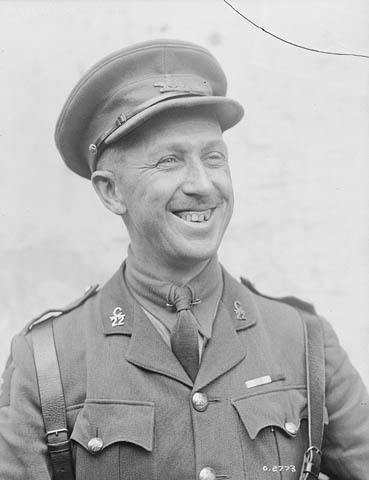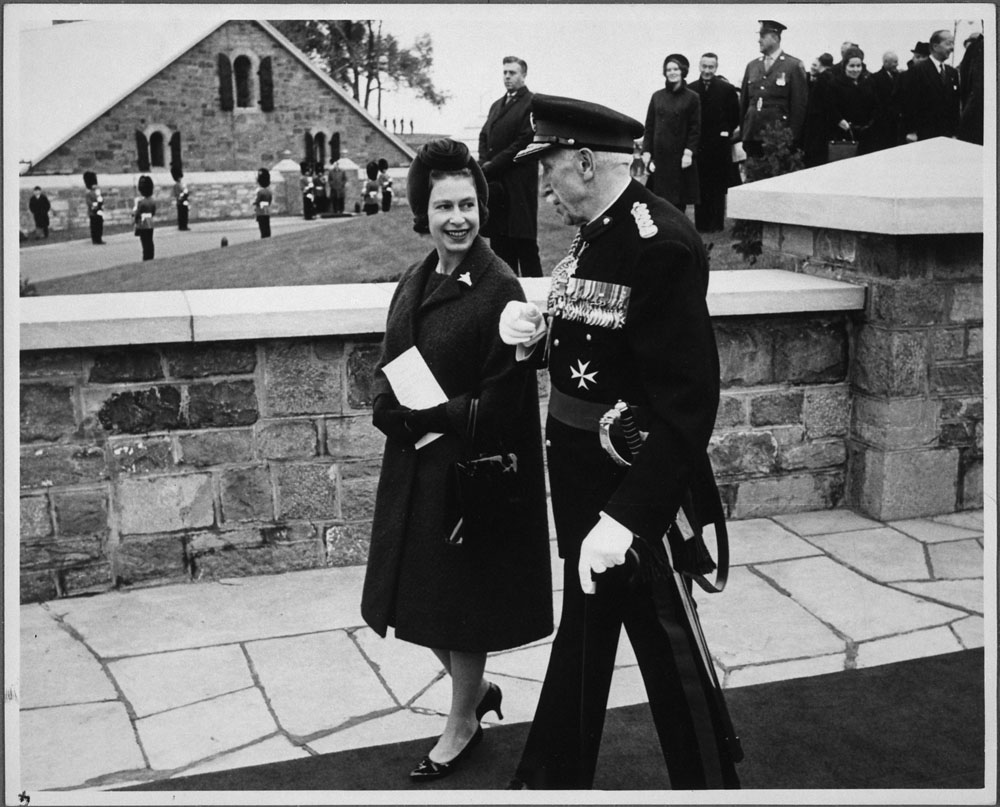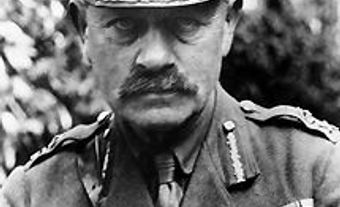
Early Life and Education
Georges Vanier was born in Montreal on 23 April 1888 to Philias and Margaret (Maloney) Vanier. After attending local schools, Georges was educated at Montreal’s Loyola College (now Concordia University). A committed Roman Catholic, he graduated in 1906 with a bachelor of arts in church devotional fellowship and began a lifelong habit of daily communion. He was the valedictorian at his graduation and won the university’s gold medal for general proficiency in philosophy. In 1911, Vanier obtained a law degree from Université Laval, and became a member of the Quebec legal bar the same year.

First World War
Vanier contemplated becoming a priest, but when the First World War erupted he felt that his immediate duty was to his country. In 1914 he became a founding officer and took a vital role in organizing the first battalion of French Canadians: the 22nd Battalion (later known as the Royal 22e Regiment, or Van Doos). He commanded the regiment from 1926 to 1928. (See also: The Van Doos and the Great War.)
Vanier served with distinction in the war. He fought at the Battle of St. Eloi Craters in 1916 and at Vimy Ridge, where he wrote to his mother after the victory in April, 1917: “You know of course that things are going with a tremendous swing and that we are pursuing the Boche (the Germans). The morale of our troops is magnificent. We cannot lose — what is more we are winning quickly and the war will be over within six months.” Vanier’s prediction was wildly optimistic. The war would continue for more than another year.

On 28 August 1918 — during the Hundred Days campaign in which the Canadian Corps helped spearhead a series of battles that finally brought the war to an end — Vanier lost his right leg to an exploding German shell, near the village of Chérisy, France. After convalescing, he refused to return home. “I simply cannot go back to Canada,” he insisted, “while my comrades are still in the trenches in France.” For his courage and leadership in the war, Vanier won the Military Cross and the Distinguished Service Order.
Diplomat
After the war, Vanier entered the diplomatic service in 1921, as aide-de-camp to Governor General Julian Byng (the British general who had commanded the Canadian Corps at Vimy Ridge).
That same year Vanier married Pauline Archer. The couple would have five children, one of whom, Jean Vanier, would go on to found L’Arche, an international movement of communities for people with developmental disabilities.
In 1928, Georges was named a member of Canada's military delegation for disarmament, to the League of Nations in London. Three years later, his diplomatic abilities won him a posting to the Canadian High Commission in London, where he served on staff until 1938.

Second World War
In 1939, with Europe again on the brink of war, Vanier was appointed Canadian minister to France. When the Germans marched into Paris in 1940, the Vaniers made a dramatic escape to London by car — but not before also arranging the evacuation of Canadian citizens and many refugees seeking escape to England.
Back in Canada during the early years of the Second World War, Vanier urged the Canadian government to accept Jewish and other refugees fleeing the Nazis. In 1940, he wrote to Prime Minister William Lyon Mackenzie King, saying that “Canada has a wonderful opportunity to be generous and yet profit by accepting some of these people.” His effort to have Ottawa ease Canada’s restrictive refugee policy was generally met with indifference and hostility.
In 1942 Vanier was promoted to major general. The following year he was sent back to London, as Canadian minister to all Allied governments in exile there. In 1944 he became ambassador to France — the first ambassador to enter the country after its liberation from German occupation.
As the war continued, Vanier and his wife helped settle returning deportees and others displaced by the conflict, especially Jewish survivors. “Today millions have been stripped, wounded and left for dead on the bloodstained roads of Europe,” said Vanier. “Is not each one of these our brother or our sister?”
In April 1945, Vanier joined a group of American congressmen touring the infamous Buchenwald concentration camp in Germany, just one week after its liberation. Shocked by what he saw, Vanier told CBC Radio: “How deaf we were then, to cruelty and the cries of pain which came to our ears, grim forerunners of the mass torture and murders which were to follow.” The Vaniers continued to urge Canada to adopt a more humane immigration policy to accept “displaced persons” from Europe after the war. The Canadian government gradually liberalized its regulations, and between 1947 and 1953, more than 186,000 European refugees settled in Canada.
Governor General
Vanier retired from diplomatic life in 1953. He became a director of a number of corporations including the Bank of Montreal and the Standard Life Assurance Company, and served on the Canada Council for the Arts.
In 1959, he accepted Prime Minister John Diefenbaker's offer to serve as Canada's first French-Canadian governor general. News of the appointment came at a meeting of the federal Cabinet in Halifax at which Queen Elizabeth II presided.
Vanier took office on 15 September 1959. “My first words are a prayer,” he said at his installation. “May almighty God . . . give peace to this beloved land of ours (and) the grace of mutual understanding, respect and love.” He added: “If Canada is to attain the greatness worthy of it, each of us must say, ‘I ask only to serve.’”
Vanier brought his lifelong religious devotion to Rideau Hall, where he converted a small upstairs bedroom into a simple chapel where he would pray twice daily. He also asked that bilingual signs be installed at the main gates of Rideau Hall. And in speeches as governor general, he frequently emphasized how Canadian unity would help anglophones and francophones live together peacefully.
In 1965 he officially inaugurated Canada’s new national flag.

Vanier’s years in office were turbulent ones because of a succession of minority governments, and the rise of violent separatism in Quebec (see Front-de-Liberation-du-Quebec). On St.Jean Baptiste Day in 1964, he was the target of separatist protesters in Montreal who called him a sellout and labelled him the Queen’s jester. Meanwhile, Vanier urged Canadians to love each other.
“The road of unity is the road of love: love of one's country and faith in its future will give new direction and purpose to our lives, lift us above our domestic quarrels, and unite us in dedication to the common good,” he said in one of his final speeches. “We can't run the risk of this great country falling into pieces.”
After the inaugural Canadian Conference on the Family, held at Rideau Hall in 1964, the Vaniers founded the Vanier Institute of the Family — to study Canadian families and promote their spiritual and material well-being.
In 1965, he created the Vanier Cup for the university football championship, as well as the Vanier Awards for Outstanding Young Canadians, awarded to deserving members of the Canadian Junior Chamber of Commerce.
In early 1967, with his health weakening, Vanier met a delegation of students from the Université de Montreal and addressed them from his wheelchair: “The measure of Canadian unity has been the measure of our success ... If we imagine we can go our separate ways within our country, if we exaggerate our differences or revel in contentions … we will promote our own destruction. Canada owes it to the world to remain united, for no lesson is more badly needed than the one our unity can supply: the lesson that diversity need not be the cause for conflict, but, on the contrary, may lead to richer and nobler living.”
Death
Vanier died in office, from heart failure, on 5 March 1967. Canadians sent more than 15,000 messages of sympathy to Rideau Hall. He was buried in the chapel of the Citadel in Quebec City, one of the governor general’s official residences.
In 1998, Maclean’s magazine named Vanier the most important Canadian in history, in a list of the country’s 100 most influential people. Wrote historian Jack Granatstein: “Vanier was Canada’s moral compass as governor general, an unquestioned man of probity and honor.”

 Share on Facebook
Share on Facebook Share on X
Share on X Share by Email
Share by Email Share on Google Classroom
Share on Google Classroom
